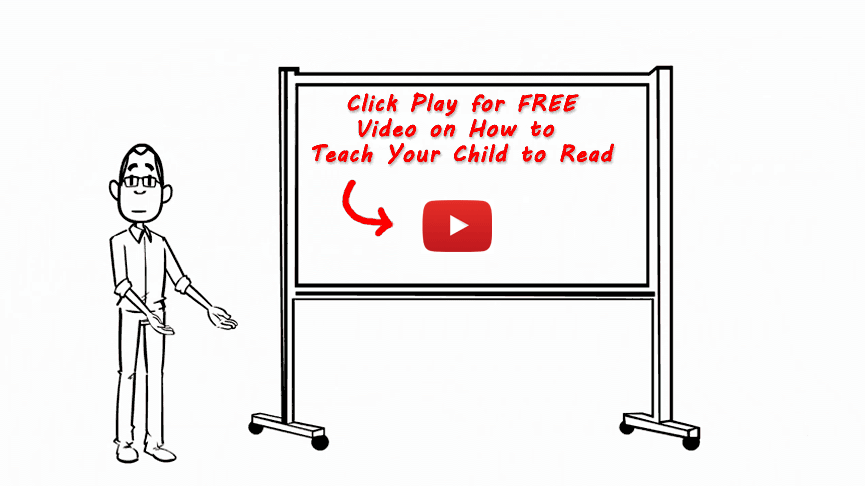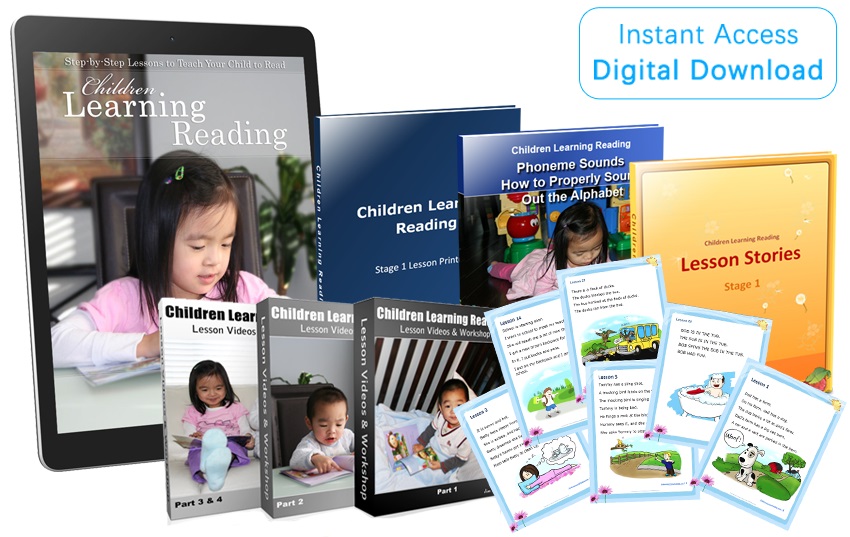Discover How To Teach Phonics Reading To Your Child
There are many methods that promise to help your child excel at reading. Quite a lot of them are used in our educational systems. Each comes with its own advantages and disadvantages. But one method that has stood the test of time is phonics teaching.
To understand why phonics education is the smartest way to teach your child how to read, you have to first be aware of what exactly the term “phonics” means.
Phonics is basically a method which utilizes the relationship between graphemes and sounds to optimize your child’s ability to be able to discover and read new words fluently.
It doesn’t just teach your child how to pronounce a set number of words; instead it shows them a technique that they can use to read any complex word.
By teaching kids phonics they will learn to read at a faster pace and develop fluent reading skills. By reading phonics, your child will be able to recognize the sounds that each individual letter makes and then progress to the sounds that different combinations of letters make. The final step is to blend these sounds together to form words.
With this knowledge your child will be able to decode any new words that they come across. It is a vital first step, and if your child learns to read with phonics they will become proficient readers as they grow older.
Strategies For Teaching Phonics
Research has proven that teaching phonics in a structured way is the most effective method of teaching young children how to read. This means that it is best to teach phonics by starting with the easiest sounds, and then progressing through to the more complex sounds.
This is the best way to teach phonics, and almost all of the children that learn this way will be equipped with the necessary skills to read new words. In time, they will progress to read all kinds of text fluently and with confidence and they will really enjoy reading.
Children that learn to read phonics tend to read more accurately than those who learned to read using other methods such as the whole language method. Included in this are dyslexic children and those that find reading difficult.
A child can learn phonics in a number of different ways. Teaching phonics that start with the easiest words and then progress to more complex ones is known as synthetic phonics. Your child will be able to relate letters to their corresponding sounds (or phonemes) using this approach, and then they will combine the individual sounds to form the complete word.
Another method of teaching phonics is through analytic phonics. With this method, there is a top down approach to reading words. The word is identified in its whole form and each of the letter sounds are analyzed in detail. If the child sees a word like “sight” this cannot easily be sounded out, so an analytic phonics approach can be helpful here.
Then there is analogy phonics, where new words are decoded using a child’s knowledge of how other similar words sound. So if the word “spun” was presented to the child, they would know that the “un” part of the word was similar to words like “fun” and “bun” and this knowledge can be applied to decoding the new word.
The Basics of Phonics
The basic foundation of phonics revolves around letters, also known as the alphabet. The smallest unit of sound in each word is called a phoneme. For a child to master phonics they must first fully understand the alphabet. This can be quite a challenge for a young child as many letters in the English alphabet represent different sounds, so the teaching of phonics sounds will be an ongoing process for your child.
Each letter has a corresponding sound. Moreover, there are groups of letters that have their own distinct sound as well. These small units can be onsets like /st/ in stove, or rimes like /ak/ in stake. They are the smallest units of a word that represents a sound.
Being aware that words are actually comprised of these little units of sounds is called phonemic awareness.
Phonics And Phonemic Awareness
Phonics and phonemic awareness are linked together, as the ability to understand phonics letter sounds relies on the child’s phonemic awareness. Your child needs to understand the phonemes in words, and also master all of the different phonemes.
When a child is young, their phonemic awareness starts to develop when they learn to speak and through listening to the words spoken by others around them. These phonemes are memorized, and can be recalled when they are being taught how to read using phonics, which makes phonics instruction a natural and effective method in early reading development.
Why is phonics important in reading?
You want your child to learn phonics because it will help them to work out the sounds used in words that are not familiar to them. They can apply their phonics knowledge to decode unfamiliar words that they encounter, and then understand the meaning of these words.
For a child to read text fluently, they need to be able to know how to say all kinds of words. They can only do this if they know that words are made up of phonemes. Using this technique, they will then be able to handle unfamiliar words with ease.
Using phonics, they can decode a word into smaller units, connect them with their appropriate sounds, and then blend them together to form a word.
Using this technique, Jim Yang (the creator of the Children Learning Reading Program) actually taught his kids how to read before they turned 3.
Now, many parents complain that their children have a short attention span. If this is true for your child, here are 3 things you need to do to make sure that your child actually looks forward to their reading lessons:-
- The text material that you use to teach your child to read should be interesting. Whether it is pictures, poems, or stories, it should align with what the child likes.
- Don’t force them to read. It should be a fun activity, not a chore. If you pressure them, they will start looking for ways to avoid their lessons, and you will also have to deal with tantrums. Be patient and creative. Make it enjoyable for them, so they look forward to it.
- Make sure you give them a solid foundation that they can use to become proficient readers. This means that you have to start with the basics.
How To Teach Kids Phonics
The most efficient way to teach kids about phonics and phonemic awareness is by following a logical progression which begins with letters, then letter sounds, after which they are taught to blend the sounds of these small units together to form whole words. You will soon find that they will be reading a series of words, and then sentences with no problem.
This method also makes them better spellers.
Although in the beginning, your child will take their time to decode and blend, with practice this process will become faster and faster to the point where they will be able to read new words without waiting to process the information.
Teaching phonics should take no longer than 10-15 minutes each day. It is important to note that these 15 minutes can be divided into smaller sessions of 4-5 minutes throughout the day. You do not need to block out hours of your day to teach your child how to read. In fact, doing so will make your child lose interest quickly.
5 Year Old Child Reading a “Technical” Book! (She Learned to Read Using Jim Yang's Reading Program)
If your child is older, you can lengthen the sessions slightly, but for toddlers keep the sessions short.
The real secret to mold them into excellent readers is to keep these lessons consistent.
While reading the text, be patient and spend time slowly reading the words out loud to them. Emphasize the phonemes so that your child recognizes these units, which in turn builds their phonemic awareness.
In fact, throughout the day, when you speak with them, you can speak slowly. For example, if you want your child to eat his food, say “Tom, E-a-t Y-o-u-r f-o-o-d”.
To make it easier for Tom to understand that you want him to eat his food, you can choose to not separate the word “food” too much.
Using words that you naturally use, and making sure you are speaking distinctively with them throughout the day, will make them learn without realizing they are actually learning.
You can also make a game out of it, where you ask your child to guess the words you are trying to say.
The time it takes for your child to master this process of decoding and blending the words depends on how fast of a learner they are. The more segmented the words are, the harder it is for them to sound them out.
For example:-
R-i-s-e R-ise
E-a-t E-at Eeeaaat
W-r-i-t-e Wr-i-te Wrrittte
The hyphens are used instead of slashes like R/I/S/E to emphasize the point that when you say the words to them, you want to emphasize the sounds and not the letters.
By focusing on sounds, you will train their ears to identify the correct sounds faster. It will develop their skills of phonics and strengthen their phonemic awareness. Even when your child masters how to use this concept, don’t stop training them. Use this technique on more difficult words. Do this for weeks, or even months. Your child will soon be able to read any piece of text without your help.
Advantages Of Learning To Read Using Phonics
There are several advantages to teaching your child how to read using phonics:
Word Deciphering Ability
Once your child has mastered phonics they will be able to decipher words that they have not seen before on their own. They will become a lot more confident with their reading and the decoding of new words will be easy for them.
Your Child Will Expand Their Vocabulary
Learning new words easily will mean that your child will be able to expand their vocabulary quickly. Through phonics instruction, your child will eventually be able to recognize whole words which will help them to become faster readers.
Fluent Recognition Of Text
There are a number of critical rules in the English language and these will all be learned through phonics training. The recognition of word patterns and the correct pronunciation rules are essential language skills that will help with the development of reading fluency.
Improved Comprehension
A child that learns to read using phonics will become a fluent reader more quickly, and they will be able to read text automatically without the need to decode each word. They will then be able to focus on the meaning of the text that they are reading, which will improve their comprehension skills.
Writing Skills Improvement
Learning to read with phonics will also help your child to develop their writing skills. Part of phonics instruction includes written lessons, where the child will complete words by writing down the missing letters etc.
The Thinking Skills Of Your Child Will Be Developed
There has been a lot of evidence gathered over the years that proves that children who have been trained in the use of phonics, tend to develop superior critical thinking skills over children that have been taught to read using other methods.
The phonics system will develop stronger analysis, logic and reasoning skills within your child, and these combined will improve your child’s overall thinking skills.
Your Child Will Have Fun Learning Phonics
There are a number of fun ways to teach phonics, and this is especially important for young children. Phonics learning games can be incorporated into the teaching, and this includes the use of colorful images that children will remember to reinforce what they have learned.
The use of a fun approach will enhance the experience of learning phonics, and will help in the development of your child’s reading and writing.
Rapidly Develop Your Child’s Reading Ability With Phonics
There is a strong correlation between learning to read using phonics, and the rapid reading development of children. If a child is taught using phonics instruction when they are young, they will significantly improve their comprehension skills as well as their spelling skills.
If you want a systematic way to teach your child how to read using the techniques mentioned above, please check out the Children Learning Reading Program by clicking the button below:








